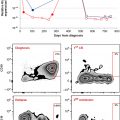Nodular Lymphocyte-Predominant Hodgkin Lymphoma
University Hospital Cologne, Cologne, Germany and German Hodgkin Study Group (GHSG), Cologne, Germany
Multiple Choice Questions
1. Nodular lymphocyte-predominant Hodgkin lymphoma (NLPHL) and classical Hodgkin lymphoma (cHL) are usually treated similarly. However, there are significant differences. With respect to which features do NLPHL and cHL differ?
- Immunohistology
- Clinical presentation
- Course of disease
- All of them
NLPHL is a rare entity accounting for about 5% of all Hodgkin lymphoma (HL) cases. It substantially differs from the histological subtypes of cHL in terms of immunohistology, clinical presentation, and course. The consistent expression of the B-cell marker CD20 represents a hallmark of the disease-defining lymphocyte predominant (LP) cells in NLPHL. In contrast, it is only infrequently found on Hodgkin and Reed−Sternberg (H-RS) cells in cHL. Further immunohistological differences between the malignant cells in NLPHL and cHL include the lack of the antigens CD15 and CD30 on LP cells; these surface antigens are typically expressed on H-RS cells. In addition, LP cells do not harbor Epstein−Barr virus (EBV) DNA, which can be found in a relevant proportion of H-RS cells. These and other markers that can be used to distinguish LP cells from H-RS cells are summarized in Table 36.1.
Table 36.1 Staining characteristics of nodular lymphocyte-predominant Hodgkin lymphoma (NLPHL) and classical Hodgkin lymphoma (cHL) (Source: Adapted and modified from Smith LB. Arch Pathol Lab Med. 2010;134(10):1434−9).
| NLPHL | cHL | |
|---|---|---|
| CD20 | + | −/+ |
| CD30 | − | + |
| CD15 | − | + |
| CD45 | + | − |
| CD79A | + | −/+ |
| EBER | − | −/+ |
| EMA | +/− | − |
| OCT-2 | + | −/+ |
| BOB.1 | + | −/+ |
| PU.1 | + | − |
EBER, in situ hybridization for EBV; EMA, epithelial membrane antigen; +, positive; −, negative; +/−, usually positive, may be negative; −/+, usually negative, may be positive.
The most comprehensive data addressing the differences between NLPHL and cHL in terms of clinical presentation and course came from the German Hodgkin Study Group (GHSG). In a retrospective analysis, Nogova and coworkers compared the characteristics and clinical outcomes of 394 NLPHL and 7904 cHL patients treated within GHSG trials. NLPHL was more often diagnosed in early favorable stages. Whereas 63% of patients with NLPHL were diagnosed with early favorable stages, 16% had early unfavorable and 21% had advanced stages. In contrast, 22%, 39%, and 39% of patients with cHL were diagnosed with early favorable, early unfavorable, and advanced stages, respectively. Furthermore, fewer patients with NLPHL had B symptoms (9% in NLPHL vs. 40% in cHL; P < 0.0001). The presence of clinical risk factors such as elevated erythrocyte sedimentation rate (ESR) (4% in NLPHL vs. 45% in cHL; P < 0.0001), the involvement of three or more nodal areas (28% in NLPHL vs. 55% in cHL; P < 0.0001), extranodal disease (6% in NLPHL vs. 14% in cHL; P < 0.0001), mediastinal bulk of more than one-third of the maximum thoracic width (31% in NLPHL vs. 55% in cHL; P < 0.0001), and elevated lactate dehydrogenase (LDH) (16% in NLPHL vs. 32 in cHL; P < 0.0001) was also less common (Table 36.2).
Table 36.2 Characteristics of nodular lymphocyte-predominant Hodgkin lymphoma (NLPHL) and classical Hodgkin lymphoma (cHL) patients (Source: Adapted and modified from Nogova L, et al. J Clin Oncol. 2008;26(3):434−9. Reproduced with permission of the American Society of Clinical Oncology.).
| NLPHL (n = 394) | cHL (n = 7904) | |
|---|---|---|
| Age (median) | 37 | 33 |
| Male gender (%) | 75 | 56 |
| B symptoms (%) | 9 | 40 |
| Elevated ESR (%) | 4 | 45 |
| 3 or more nodal areas involved (%) | 28 | 55 |
| Extranodal disease (%) | 6 | 14 |
| Large mediastinal mass (>1/3 of the maximum thoracic width) (%) | 31 | 55 |
| Elevated LDH (%) | 16 | 32 |
| Early favorable stages (%) | 63 | 22 |
| Early unfavorable stages (%) | 16 | 39 |
| Advanced stages (%) | 21 | 39 |
ESR, erythrocyte sedimentation rate; LDH, lactate dehydrogenase.
After adequate stage-adapted chemotherapy and/or radiotherapy (RT), NLPHL patients included in the GHSG analysis had an excellent clinical outcome. Freedom from treatment failure (FFTF) and overall survival (OS) rates after a median observation of 50 months were 88% and 96%, respectively. However, especially patients with more advanced disease at initial diagnosis showed a tendency to develop late relapses. As compared with 8.6% of cHL patients, 23.5% of NLPHL patients initially treated for early unfavorable and advanced stages relapsed more than one year after completion of first-line treatment. In contrast, NLPHL patients treated for early favorable stages had no increased rate of late relapses (4.8% in NLPHL vs. 6.4% in cHL; P = 0.3991). The frequency of early relapses did also not significantly differ between NLPHL and cHL.
In summary, NLPHL is characterized by pathological and clinical features that differ significantly from those of cHL. However, the outcome is excellent with standard HL treatment approaches.
2. In cHL, combined-modality treatment (CMT) was shown to result in a superior clinical outcome as compared with RT alone and is thus considered the standard of care for early favorable stages. In NLPHL, RT alone still represents the widely accepted standard of care for stage IA disease without clinical risk factors. Is this recommendation based on randomized clinical trials?







